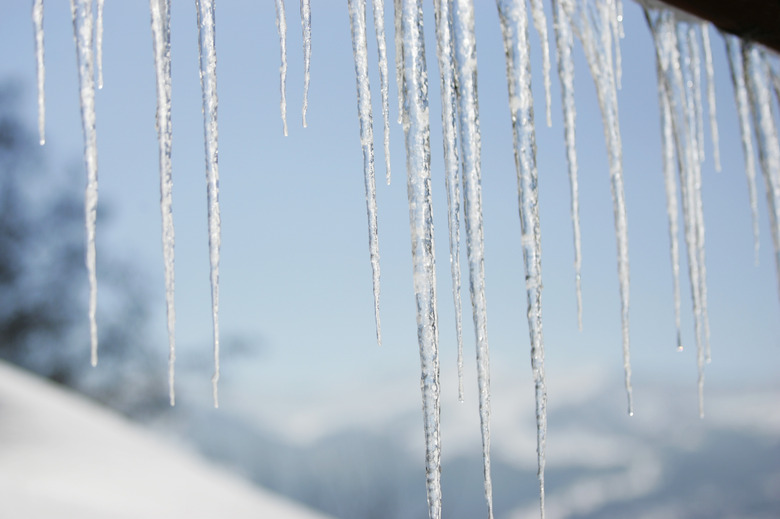Freezing Rain Facts
Wind, rain and snow are all common types of weather and precipitation that many of us are used to seeing, or at least hearing about. Freezing rain, though, might be a bit more mysterious to those of us who haven't experienced it before.
Freezing rain, occasionally called ice rain, actually appears as "normal" rain. However, thanks to much colder temperatures closer to the ground, the droplets of rain reach temperatures below freezing while they're still in their liquid raindrop form. Hence the name freezing rain: it's rain that has a temperature below freezing.
This results in almost instant ice when the droplets finally reach the ground or any other surface they hit along the way.
What Is Freezing Rain?
What Is Freezing Rain?
Freezing rain facts must begin with what freezing rain actually is.
Freezing rain is "regular" liquid rain that goes through a supercooling process thanks to varying temperature levels that form in the atmosphere. It's called freezing rain because the temperature of the raindrops is actually below freezing despite being in a liquid form.
This causes the drop to instantly freeze upon contact with any surface. This could be the ground, tree branches, birds and anything else in the air or on the surface of the Earth.
How Does Freezing Rain Form?
How Does Freezing Rain Form?
Freezing rain forms thanks to temperature differences that occur in layers in the atmosphere. When a rain or snow storm forms, the top-most layer (where the storm clouds are) is a cold layer. The precipitation will form as either snow or very cold rain.
That precipitation will fall and reach a large warm layer of air. This forces all of the precipitation back into rain (liquid water). This warm layer is very large, which forces much colder air underneath it to form a very small layer close to the surface. When the rain hits this very cold layer, a supercooling effect occurs that causes the rain to reach below-freezing temperatures.
However, because this cold layer is so small, the rain doesn't have time to actually freeze into snow or ice when it's in the air. Instead, it will instantly freeze and form sheets of ice once it hits a surface. This is usually the ground, trees, homes and even planes.
Sleet vs. Freezing Rain
Sleet vs. Freezing Rain
Sleet forms in the exact same way as freezing rain. The difference, though, is the size of the warm layer of air that the precipitation passes through.
With freezing rain, the layer is so large that it doesn't give the rain time to freeze in the air once it reaches the lower cold layer. Sleet, on the other hand, forms when that warm layer is much smaller.
Once the precipitation passes through that smaller warm layer, it reaches a cold layer that also supercools the liquid to freezing. Because this cool layer is larger, it allows the drops to fully freeze the raindrops into tiny ice pellets that we know as sleet.
In short, freezing rain freezes when it hits the ground or another surface whereas sleet freezes before it makes contact with the ground or a surface.
Freezing Rain Effects
Freezing Rain Effects
Freezing rain is one of the most dangerous types of weather conditions. It has one of the highest rate of accidents for any type of weather, especially for car and other vehicle accidents.
Freezing rain can also cause damage to the environment. When freezing rain hits trees, it freezes on their branches, which adds a large amount of weight to them. This can cause branches to snap and break off, thus damaging the tree. Falling branches can also damage power lines, houses, cars and even people.
Freezing rain is especially dangerous for birds. They're the most likely to get hit with freezing rain in the air. This causes ice to coat their bodies and feathers, which can result in them being unable to fly properly. This prevents them from getting food, finding shelter, escaping predators and more. It also can lower their body temperature to dangerously low levels, which can result in death.
Humans are affected as well. Besides the increased risk of accidents thanks to icy roads and falling trees and branches, it can also affect power and electricity lines when it freezes directly on the lines.
Cite This Article
MLA
Walsh, Elliot. "Freezing Rain Facts" sciencing.com, https://www.sciencing.com/freezing-rain-19674/. 15 July 2019.
APA
Walsh, Elliot. (2019, July 15). Freezing Rain Facts. sciencing.com. Retrieved from https://www.sciencing.com/freezing-rain-19674/
Chicago
Walsh, Elliot. Freezing Rain Facts last modified March 24, 2022. https://www.sciencing.com/freezing-rain-19674/
